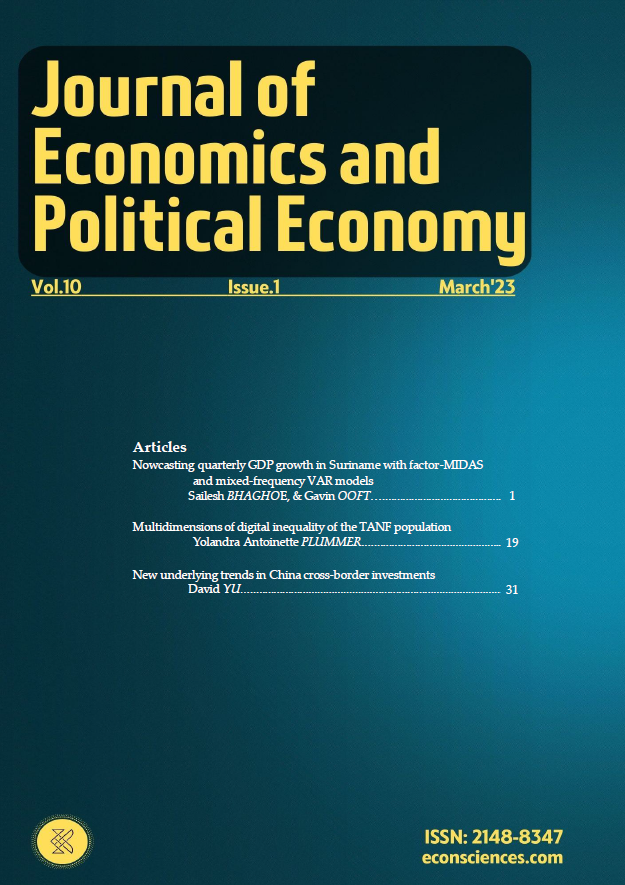Abstract
This study applies the multidimensional digital inequality framework to analyze the complex ways in which digital access varies among low-income populations. This research specifically examines the results of digital skills training for individuals receiving Temporary Assistance for Needy Families (TANF) benefits and how it shapes their Internet use as well as returns of use. The research shows the importance of the multidimensional nature of digital inequality, focusing on how access and use of digital technologies varies among individuals with formal digital literacy skills training. Findings from the research offer insight into the need for additional technological investments and multistakeholder engagement.
Keywords: digital inequality, digital literacy skills, low-income populations, NorthStar assessment.
JEL Class.: I23, I24, I38, J15.
References
2Gen Approach. (2022, September 22). Ascend at the Aspen Institute.
https://ascend.aspeninstitute.org/2gen approach/
APLU. (2022, December 28). Land-grant university faq.
www.aplu.org/about-us/history-of-aplu/what-is-a-land grant-university/
Blank, G., and Groselj, D. (2014). Dimensions of internet use: Amount, variety, and types. Information, Communication & Society, 17(4), 417–435. doi: 10.1080/1369118X.2014.889189.
Bowser administration to celebrate infrastructure week by highlighting District investments. (n.d.). DMOI.
Census Reporter. (n.d.). Census profile: Washington, DC.
https://censusreporter.org/profiles/16000US11150000-washington-dc/
DiMaggio, Paul, Hargittai, E., Celeste, C. and Shafer, S. (2004). Digital inequality: From unequal access to differentiated use in Social Inequality. pp. 355-400, Russell Sage Foundation.
Dolan, J.E. (2016). Splicing the divide: A review of research on the evolving digital divide among K–12 students. Journal of Research on Technology in Education, 48(1), 16-37.
https://doi.org/10.1080/15391523.2015.1103147
Goldberg, Heidi. (2002).
Halverson, E.R., & Sheridan, K. (2014). The maker movement in education. Harvard Educational Review, 84(4), 495–504. https://doi.org/10.17763/haer.84.4.34j1g68140382063
Helsper, E. (2021). The Digital Disconnect. SAGE Publications.
2020 SPEAKERS, Helsper. (2020, September 15). UK IGF. https://ukigf.org.uk/ukigf-2020-speakers/
Helsper E.J. (2008) Digital inclusion: An analysis of social disadvantage and the information society. London: Communities and Local Government.
Microsoft. (n.d.). How the University of D.C. is working to close the digital divide. Microsoft Education Blog.
Neuman, S.B. and Celano, D. (2006). The knowledge gap: Implications of leveling the playing field for low-income and middle-income children. Reading Research Quarterly, 41, 176-201 https://osf.io/ztqg6 , https://doi.org/10.1598/RRQ.41.2.2
Nussbaum, M.C. (2001). Women and human development: The capabilities approach. (The Seeley Lectures: Series Number 3) (revised). Cambridge University Press.
Presidential committee on information literacy: Final report. (2012, November 21). Association of College and Research Libraries (ACRL). https://www.ala.org/acrl/publications/whitepapers/presidential
Rowsell, J and Morrell, E. (n.d.).Digital Divide. International Literacy Association
https://www.literacyworldwide.org/get-resources/instructional-practices/digital-divide
van Deursen, Alexander. J.A.M. (2020). Digital inequality: During a pandemic: quantitative study of differences in COVID-19-related Internet uses and outcomes among the general population. Journal of Medical Internet Research, 22(8). [e20073]. https://doi.org/10.2196/20073
van de Werfhorst, Herman G. Kessenich, Emma and Geven, Sara (2022). The digital divide in online education: Inequality in digital readiness of students and schools. Computers and Education Open, 3,100100. https://doi.org/10.1016/j.caeo.2022.100100.
van Dijk, J.A. G. M. (2013). A theory of the digital divide. In Ragnedda, Massimo and Muschert, G. W. (Eds.) The digital divide, Routledge, Abingdon. 29-51
van Dijk, Jan A.G.M. (August-October 2006). Digital divide research, achievement, and shortcomings. Poetics, 34(4-5), 221-235. https://doi.org/10.1016/j.poetic.2006.05.004
van Dijk, J.A.G.M. (2006). Digital divide research, achievement, and shortcomings. 221-331.
van Dijk, J.A.G.M. (2005). The deepening divide: Inequality in the information society. Sage Publications. London, UK.
Vulture, C. (2022, March 7). A simple guide to cultural competency training. Commisceo Global Consulting Ltd.
http://www.commisceo-global.com/blog/a-simple-guide-to-cultural-competency-training
Yee, V., Bajaj, S.S., and Stanford, F.C. (2022). Paradox of telemedicine: building or neglecting trust or equity. 480-81. https://doi.org/10.1016/S2589-7500(22)00100-5

This work is licensed under a Creative Commons Attribution-NonCommercial 4.0 International License.
